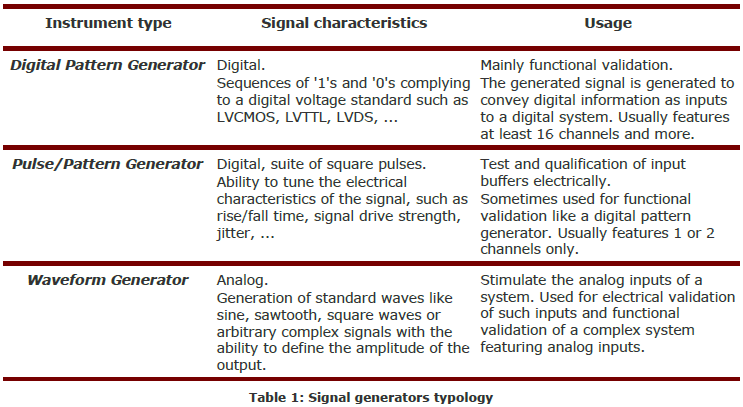In the world of signal generators used for testing and debugging embedded systems, we can find 3 categories of instruments, according to the characteristics of the generated signals and the purpose of generating them. 'Embedded system' should be understood in its broad sense, that is an electronic system with 'out of the PC' computing resources such as microprocessor or microcontroller, ASIC, FPGA, SoC (System-on-Chip), DSP, including analog, digital or mixed-analog/digital systems. Refer to the table below for an overview.
 In this blog post, we'll specifically evoke the 'Digital Pattern Generator' as an essential piece equipment for all engineers involved in embedded system design.
In this blog post, we'll specifically evoke the 'Digital Pattern Generator' as an essential piece equipment for all engineers involved in embedded system design.
Digital pattern generator improves digital system testing during design
During design, the digital pattern generator is an essential stimulus source for almost every type of digital device: digital and mixed-signal ASIC, FPGA, microprocessors and microcontrollers. The digital pattern generator is useful for functional testing, debug of new designs and failure analysis of existing designs.
The digital pattern generator can be used early in the design cycle to substitute for system components that are not yet available. For example, a digital pattern generator might be programmed to send interrupts and data to a newly developed bus circuit when the processor that would normally provide the signals doesn't yet exist.
It allows exploring new test cases – and create infrequently encountered test conditions to help verify that a code works and is robust enough – and this, before the complete hardware is even available.
A digital pattern generator can also be used to put a circuit into a desired state and then let it operate at full speed or step the circuit through a series of states. Generating the right specific initialization sequences and configuring control register will help in exploring many modes of operations of a circuit. Because nowadays circuits use digital interfaces that may run at more than a few 10th of megahertz, the old way to do it with microcontrollers coupled with a GPIO is not sufficient any more.
By substituting for missing pieces and offering maximal flexibility when generating digital logic signals, digital pattern generators will speed up new product's time-to-market. The digital pattern generator is an effective solution just about anywhere that complex digital bit streams are needed to stimulate a device under test (DUT)
Download the full article provided by ByteParadigm here...


